User:Cease/Temp4
Raiders are the evil men who live in the domains under Sauron's shadow from the lands to the south and east of Gondor and Rohan. In this game,
Raider culture is one of two Shadow cultures of evil man minions, and is itself split into three subcultures: the ambushing, oliphaunt-riding archers of the Southron Haradrim, the disciplined, ferocious warriors of the Easterlings, and the larcenous piratical Corsairs of Umbar. Dark-skinned, evil, stereotypes of vaguely Persian or Turkic invaders who subscribe to an evil foreign religion is not a concept that has aged terribly well, but, hey, playing them means sometimes you get to step on Legolas with a giant war elephant or send an unkempt Peter Jackson to single-handedly crush the entire Fellowship, so you take the good with the bad.
Raider culture as a whole was first introduced in The Two Towers, alongside another, separate faction of evil men,
Dunland. Initially,
Raiders only included the first two subcultures, Southrons and Easterlings. Both subfactions received more cards and developed over the course of Tower Block, but really came into their own with The Return of the King. Then Siege of Gondor introduced Corsairs and their boats, introducing what would remain a top-tier strategy in Movie Block to this day.
All three Raider subcultures were retired after King Block. The 11th set, Shadows, reorganized and consolidated the Shadow cultures. All of
Raider culture was combined with the other evil men to make
Men culture.
The entire culture is one culture, but the way it's split into three means that most decks pick a subculture and stick with it, only using cards from other subcultures to supplement their strategy. In this way, Raider culture resembles
Isengard, although the subcultural enforcement isn't nearly so strong. Part of the looseness of this subcultural enforcement is that some cards are weakly aligned with one subfaction or another. A card like Discovered (4R223)
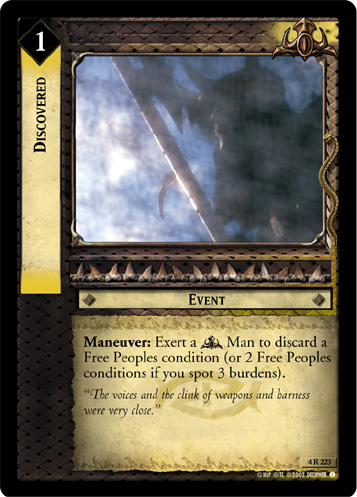 meshes well with the Easterling plan of placing and spotting burdens, but it's a useful tool for all three subcultures.
meshes well with the Easterling plan of placing and spotting burdens, but it's a useful tool for all three subcultures.
Raiders have powerful but generally expensive event cards. Case in point, Discovered (4R223)
 is a staple of Raider
is a staple of Raider
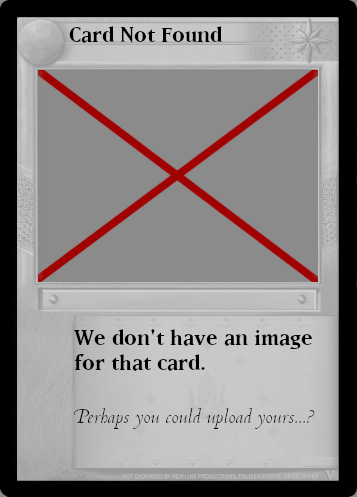 decks. That isn't as memorable as the flashy, expensive, and risky cards to unexpectedly remove troublesome companions: Whirling Strike (4C260)
decks. That isn't as memorable as the flashy, expensive, and risky cards to unexpectedly remove troublesome companions: Whirling Strike (4C260)
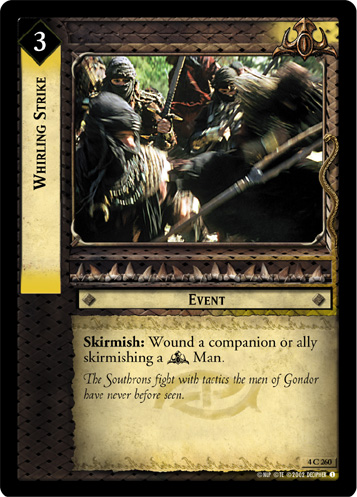 , Red Wrath (7U157)
, Red Wrath (7U157)
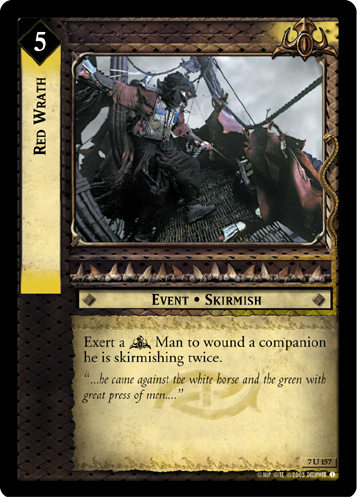 , and Fierce in Despair (7R148)
, and Fierce in Despair (7R148)
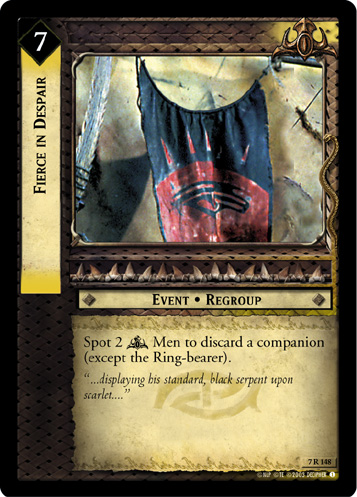 . In theory, these three cards are meant to enable a strategy where you use the Southron signature keyword Ambush to pay for these powerful events, but the most popular Ambush card isn't an Southron card anyway! In practice, they're mostly used to soak up extra twilight from an opponent who has flooded, which is common in Movie Block. This predilection for expensive events also extends to many of their more mundane effects: non-Corsair subcultures have relatively overpriced pump events, On the March (4C241)
. In theory, these three cards are meant to enable a strategy where you use the Southron signature keyword Ambush to pay for these powerful events, but the most popular Ambush card isn't an Southron card anyway! In practice, they're mostly used to soak up extra twilight from an opponent who has flooded, which is common in Movie Block. This predilection for expensive events also extends to many of their more mundane effects: non-Corsair subcultures have relatively overpriced pump events, On the March (4C241)
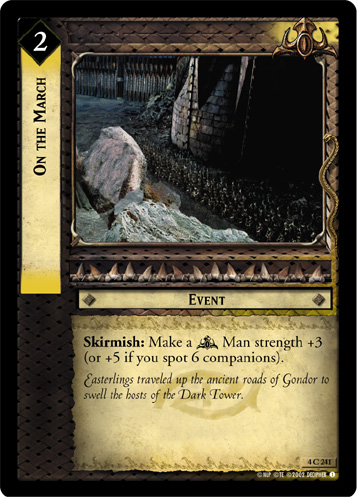 and New Strength Came Now (7C154)
and New Strength Came Now (7C154)
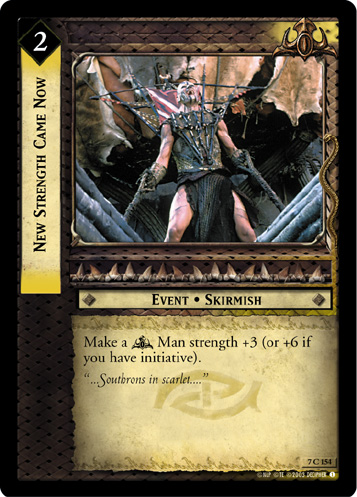 . These are rarely played; instead, players tend to use the many
. These are rarely played; instead, players tend to use the many Raider utility conditions like Under Foot (10C52)
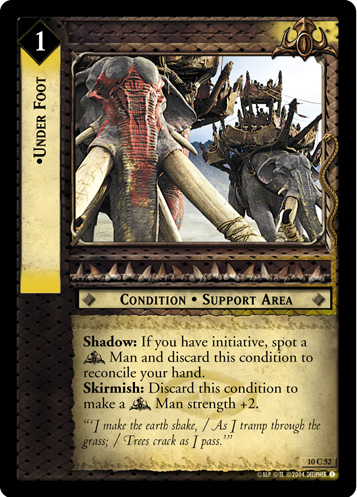 , Small Hope (7R159)
, Small Hope (7R159)
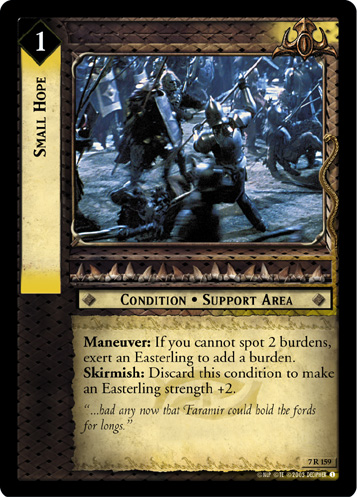 , and Field of the Fallen (10U43)
, and Field of the Fallen (10U43)
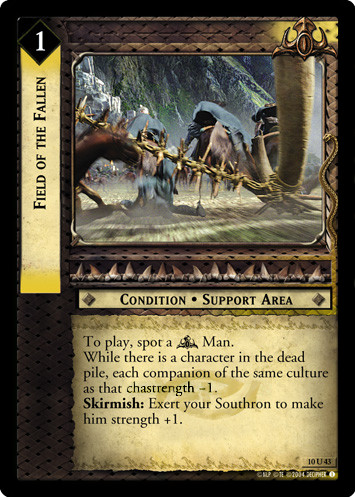 that have pump effects attached to their main effect.
that have pump effects attached to their main effect.
Speaking of which, Raiders have powerful support area cards to enable cycling. Under Foot (10C52)
 is a keystone of swarming strategies (often multicultural or rainbow strategies like Moria Navy or Stupid Swarm). Ships of Great Draught (8R65)
is a keystone of swarming strategies (often multicultural or rainbow strategies like Moria Navy or Stupid Swarm). Ships of Great Draught (8R65)
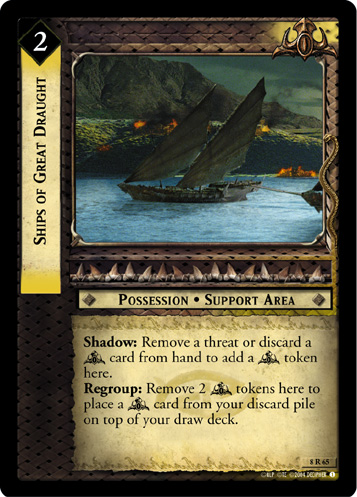 not only allows you to never have to worry about a hand clogged with Shadow cards, but also lets you retrieve a situational card or play a particularly troublesome card over and over again. With the addition of Corsair War Galley (8U59)
not only allows you to never have to worry about a hand clogged with Shadow cards, but also lets you retrieve a situational card or play a particularly troublesome card over and over again. With the addition of Corsair War Galley (8U59)
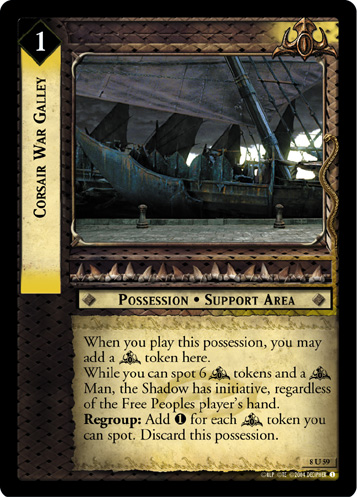 , this can also give you a near-continuous hold on Initiative, needed to enable certain Southron and Corsair strategies.
, this can also give you a near-continuous hold on Initiative, needed to enable certain Southron and Corsair strategies.
In theory, Raiders also have strong shared possessions that you play on minions, like Raider Bow (7C155)
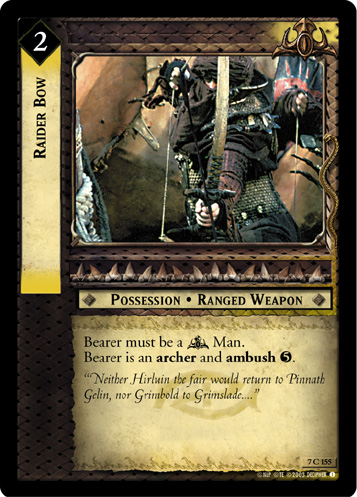 and Raider Polearm
and Raider Polearm
 . In practice, both of these cards are only common in one single subculture, and neither one is popular in the culture it's styled after! Both of them appear below along with the corresponding decks.
. In practice, both of these cards are only common in one single subculture, and neither one is popular in the culture it's styled after! Both of them appear below along with the corresponding decks.
Most Raider minions are too tightly integrated into their subculture to really work in any deck that isn't devoting significant space to
Raider cards. There's one exception: Desert Lord (4R219)
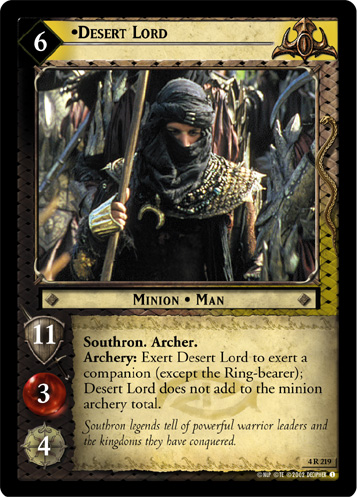 . He's great for exhausting annoying characters that need to exert to use their abilities, like Legolas, Greenleaf (1R50)
. He's great for exhausting annoying characters that need to exert to use their abilities, like Legolas, Greenleaf (1R50)
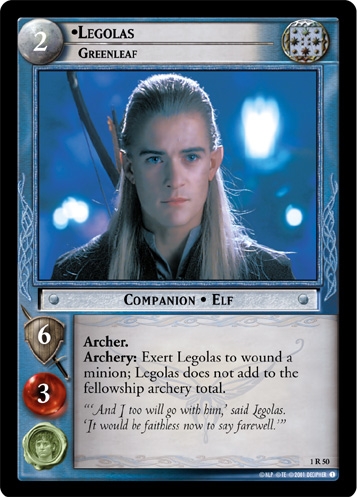 , Círdan, The Shipwright (10R8)
, Círdan, The Shipwright (10R8)
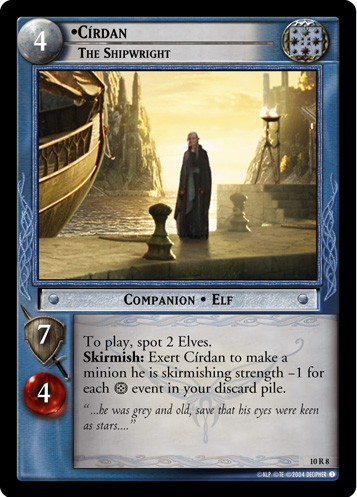 , and Éowyn, Lady of Ithilien (10R72)
, and Éowyn, Lady of Ithilien (10R72)
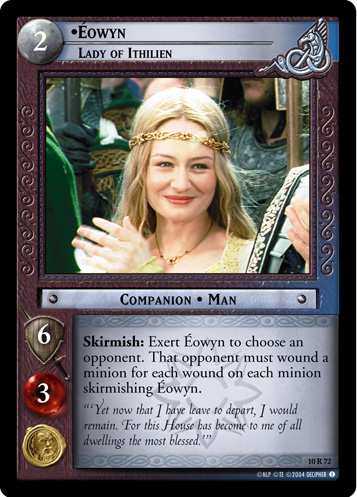 . You can just slam him down, get two direct wounds out of him, and maybe even get a third one when he goes to skirmish. He's just a really great value card that fits into a variety of decks.
. You can just slam him down, get two direct wounds out of him, and maybe even get a third one when he goes to skirmish. He's just a really great value card that fits into a variety of decks.
Southrons
See also: Southron
Southrons have turbans and bows and they're sneaky ambushing desert warriors but also they have oliphaunts. I guess they're sneaky giant war elephants. Southrons want to have lots of twilight sloshing around after the Shadow Phase to pay for expensive events and minion abilities. They also want to have initiative, they like to generate and spot and consume threats, and occasionally they capture sites. They also notably dislike overly large or multicultural Fellowships. Their subcultural enforcement is sometimes tricky: if a card mentions "a archer" or "a mounted
Man" then it's a card for Southrons, since they have (almost) all of the
Raider archers and all of the
Raider mounts. They have three sets of basic tools plus some utility cards that appear in a variety of Southron decks, and these come together to make about two and a half common decks.
The first tool is the the signature Southron keyword, but also the least-successful Raider gimmick overall. Ambush generates twilight when minions are assigned. In theory, you'd use it to fund the expensive
Raider events, or conditions like Howl of Harad (4U236)
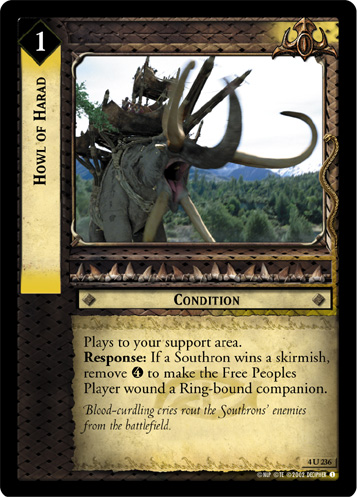 or Harsh Tongues (7C150)
or Harsh Tongues (7C150)
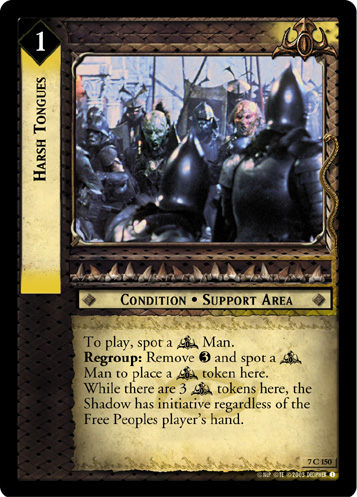 , or some of the other gimmicks below. In practice, the Ambush numbers are too small to pay for very much, and the minions with Ambush are largely too weak to be worth bothering with. Insofar as Ambush is used in Southron decks at all, it's largely in support of Southron direct wounding, or just a little extra on a card that's good enough to use anyway.
, or some of the other gimmicks below. In practice, the Ambush numbers are too small to pay for very much, and the minions with Ambush are largely too weak to be worth bothering with. Insofar as Ambush is used in Southron decks at all, it's largely in support of Southron direct wounding, or just a little extra on a card that's good enough to use anyway.
The second main gimmick is direct wounding. Cards like Desert Warrior (4C222)
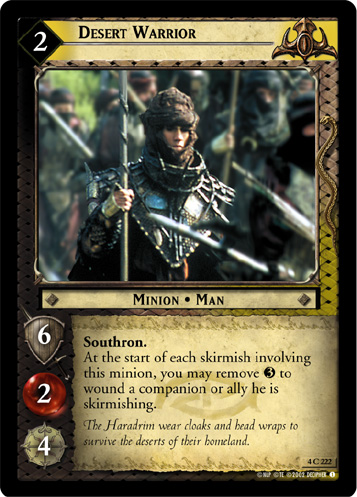 and Desert Sneak (7C135)
and Desert Sneak (7C135)
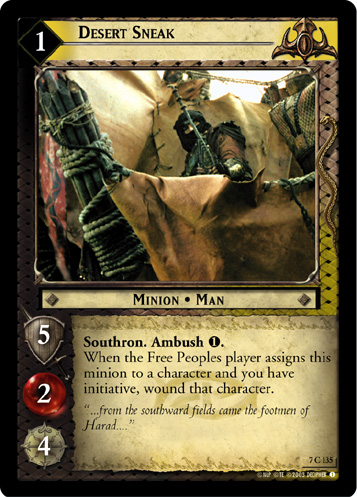 trigger at the beginning of a skirmish, either consuming twilight or looking for initiative to cause a wound. Of these, the initiative cards are the most successful, in decks using Corsair War Galley (8U59)
trigger at the beginning of a skirmish, either consuming twilight or looking for initiative to cause a wound. Of these, the initiative cards are the most successful, in decks using Corsair War Galley (8U59)
 (or, sometimes, Harsh Tongues (7C150)
(or, sometimes, Harsh Tongues (7C150)
 ) to seize initiative. There are a number of options to spend twilight to trigger wounds later in the turn as well, like Howl of Harad (4U236)
) to seize initiative. There are a number of options to spend twilight to trigger wounds later in the turn as well, like Howl of Harad (4U236)
 or Cast Unto the Winds (10C36)
or Cast Unto the Winds (10C36)
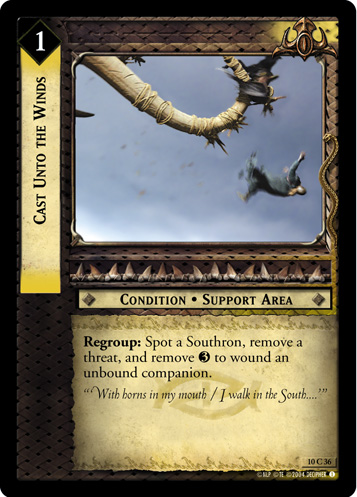 , or the expensive wounding events like Whirling Strike (4C260)
, or the expensive wounding events like Whirling Strike (4C260)
 and Red Wrath (7U157)
and Red Wrath (7U157)
 . (There are a number of other similar cards that pay twilight later in the turn for various effects, such as Army of Haradrim (5R70)
. (There are a number of other similar cards that pay twilight later in the turn for various effects, such as Army of Haradrim (5R70)
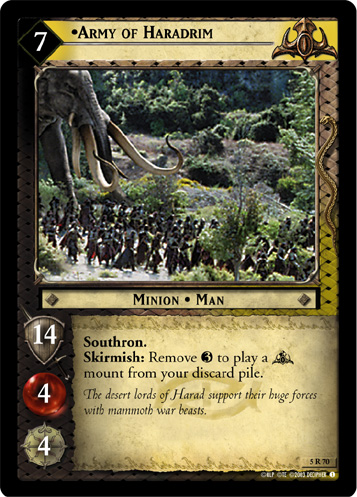 or Dark Tidings (7C130)
or Dark Tidings (7C130)
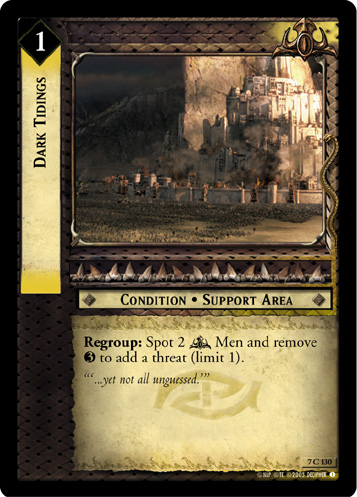 , but most of these effects are overcosted and less useful than direct wounding, and as such are rarely played.) As mentioned before, you're theoretically meant to pay for these cards with Ambush, but the only Ambush card really worth using to generate twilight is Raider Bow (7C155)
, but most of these effects are overcosted and less useful than direct wounding, and as such are rarely played.) As mentioned before, you're theoretically meant to pay for these cards with Ambush, but the only Ambush card really worth using to generate twilight is Raider Bow (7C155)
 .
.
The third and final one is archery. Southron archery aren't quite as dirt-cheap as Moria
 's: the cheapest ones are Southron Bowman (4C248)
's: the cheapest ones are Southron Bowman (4C248)
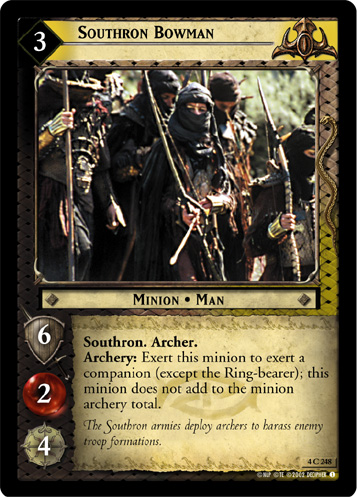 and Southron Archer (4R245)
and Southron Archer (4R245)
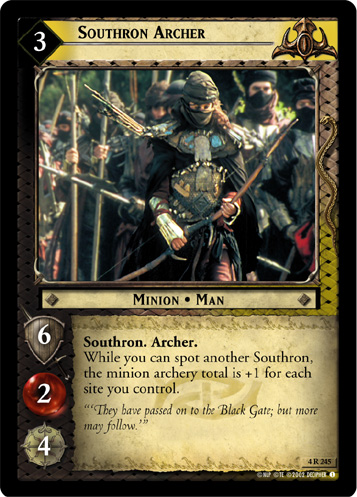 , followed by Elite Archer (4U232)
, followed by Elite Archer (4U232)
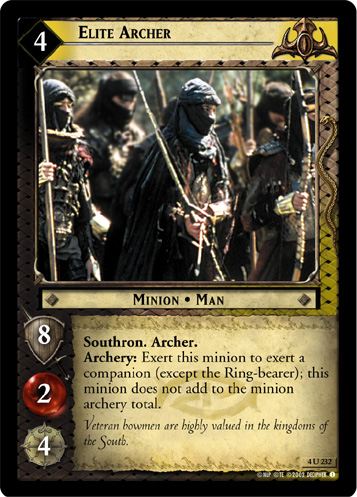 . But they also have archer minions with enough strength to skirmish decently well, with Desert Lord (4R219)
. But they also have archer minions with enough strength to skirmish decently well, with Desert Lord (4R219)
 , Haradrim Marksman (8U60)
, Haradrim Marksman (8U60)
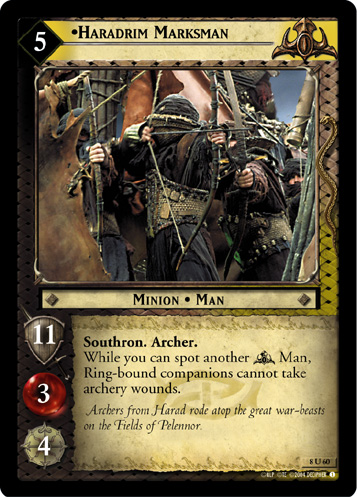 , and Southron Marksmen (7R167)
, and Southron Marksmen (7R167)
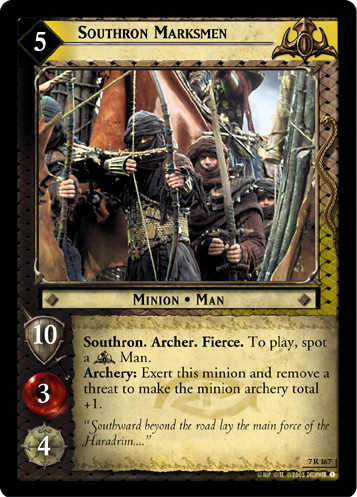 . (This is a dynamic that will be familiar to anyone who has played Uruk Archery.) There are some more-expensive archers that can exploit a heavily flooded twilight pool, but they are overpriced and not popular.
. (This is a dynamic that will be familiar to anyone who has played Uruk Archery.) There are some more-expensive archers that can exploit a heavily flooded twilight pool, but they are overpriced and not popular.
Then there's the shared Southron bag of tricks. Southrons love to have a bunch of threats sloshing around, and Rallying Call (10U47)
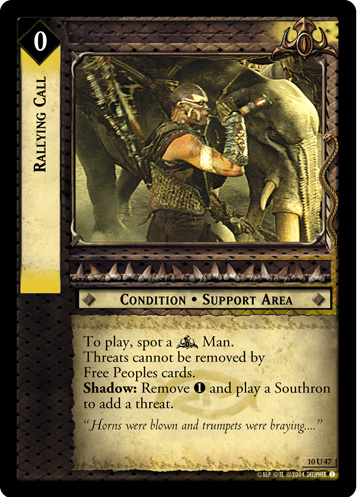 can generate those threats cheaply. These threats can be turned into wounds by killing a companion, or used to fund cards like Southron Marksmen (7R167)
can generate those threats cheaply. These threats can be turned into wounds by killing a companion, or used to fund cards like Southron Marksmen (7R167)
 or Ships of Great Draught (8R65)
or Ships of Great Draught (8R65)
 . Southrons can also turn unexpectedly large or get an unexpected extra use of their exertion or Ambush abilties, with cards like Mûmak (5C73)
. Southrons can also turn unexpectedly large or get an unexpected extra use of their exertion or Ambush abilties, with cards like Mûmak (5C73)
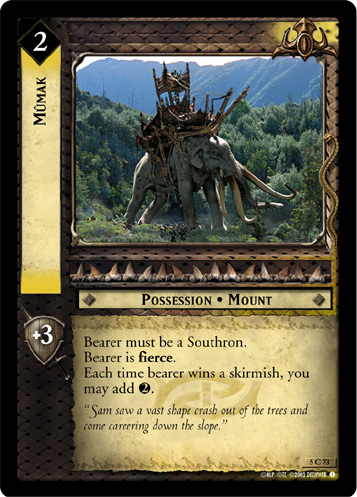 , Seasoned Leader (10R48)
, Seasoned Leader (10R48)
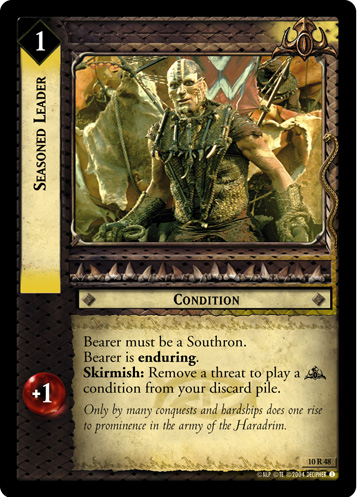 , and Field of the Fallen (10U43)
, and Field of the Fallen (10U43)
 . Combine two or three of these cards to turn even relatively meek minions into skirmishing behemoths. (There's even a very dirty combo where you recycle an Under Foot (10C52)
. Combine two or three of these cards to turn even relatively meek minions into skirmishing behemoths. (There's even a very dirty combo where you recycle an Under Foot (10C52)
 in your discard pile over and over with Seasoned Leader (10R48)
in your discard pile over and over with Seasoned Leader (10R48)
 to turn 1 threat and 1 twilight into +2 strength, until you run out of threats or twilight.) They also have some above-average hate cards for overly large or rainbow Fellowships, such as Southron Leader (7R166)
to turn 1 threat and 1 twilight into +2 strength, until you run out of threats or twilight.) They also have some above-average hate cards for overly large or rainbow Fellowships, such as Southron Leader (7R166)
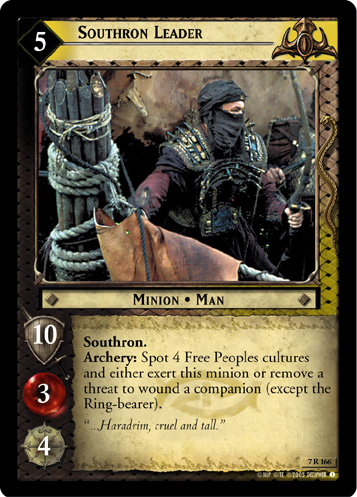 and Southron Veterans (4R257)
and Southron Veterans (4R257)
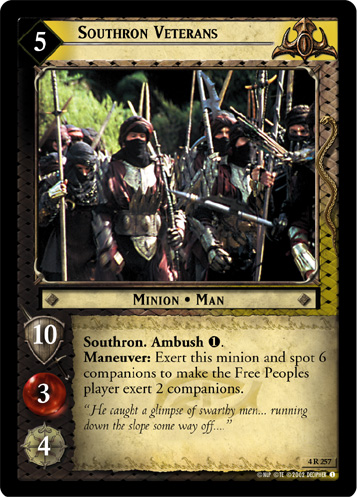 . All of these cards are fairly situational, but that's fine! As long as you have Ships of Great Draught (8R65)
. All of these cards are fairly situational, but that's fine! As long as you have Ships of Great Draught (8R65)
 , you can pitch them into discard easily, or retrieve them later at your convenience.
, you can pitch them into discard easily, or retrieve them later at your convenience.